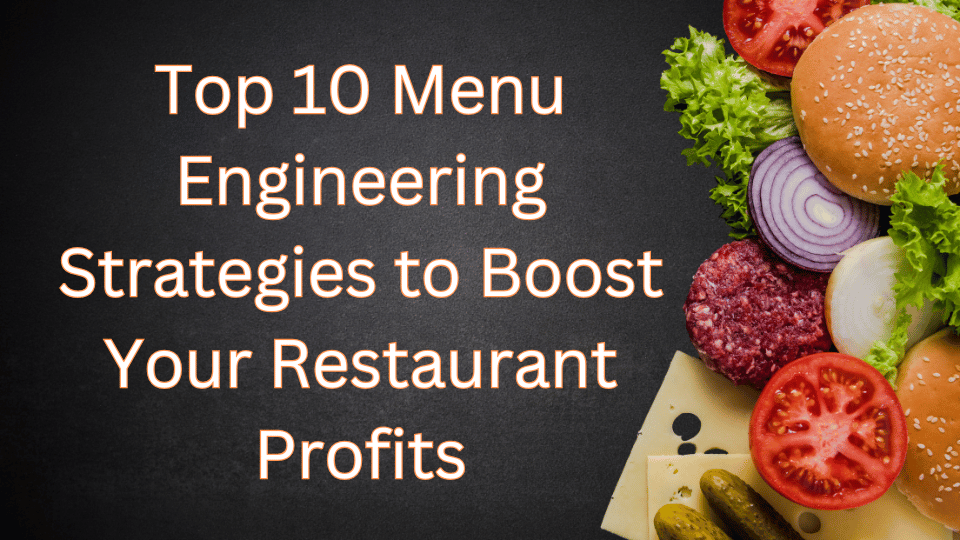A well-designed menu is more than just a list of food items; it’s a strategic tool that can significantly impact your restaurant’s profitability. Menu engineering is the process of analyzing and optimizing your menu to maximize revenue by encouraging customers to order high-margin items. In this article, we’ll explore 10 effective menu engineering strategies to help boost your restaurant’s profits.
1. Categorize Menu Items by Profitability and Popularity
The foundation of menu engineering is to evaluate each dish based on two key factors: profitability and popularity. Menu items typically fall into one of four categories:
- Stars: Popular and highly profitable.
- Plow Horses: Popular but less profitable.
- Puzzles: Highly profitable but not ordered often.
- Dogs: Neither profitable nor popular.
How to Use It: Focus on promoting stars, improving puzzles through marketing or repositioning, and either improving the profitability of plow horses or phasing out dogs to free up space for better options.
2. Highlight High-Profit Items
When designing your menu, ensure that your high-margin items catch the customer’s eye. Strategic use of highlight boxes, bold fonts, or creative names can draw attention to these dishes without being too obvious.
How to Do It:
- Place high-margin items in premium spots like the upper-right corner or the first and last items of each section. These are the areas customers focus on the most.
- Use design elements like bold fonts, larger text, or creative descriptions to make high-profit items stand out.
3. Optimize Menu Layout for Psychology
The way your menu is organized can influence customer behavior. People typically read menus in a “Z” pattern, starting at the top-left corner and moving across to the right. Placing high-margin items in these prime spots can lead to more sales.
How to Do It:
- Group similar items together in clearly defined sections (e.g., appetizers, entrees, desserts).
- Avoid cluttering the menu with too many options. A clean, simple design helps customers make quicker decisions and encourages higher spending.
4. Use Descriptive Menu Language
The language you use to describe your menu items can make a big difference in how appealing they seem. Vivid, mouth-watering descriptions can increase the perceived value of a dish, allowing you to charge higher prices without much resistance.
How to Do It:
- Use sensory words like “crispy,” “succulent,” or “savory” to paint a picture in the customer’s mind.
- Incorporate storytelling by describing the source of ingredients (e.g., “locally-sourced organic tomatoes”) to enhance the perceived quality of the dish.
5. Price Strategically Without the Dollar Sign
Customers often associate prices with the dollar sign, which can trigger a focus on cost rather than value. Studies show that removing the dollar sign from your menu can increase spending because it reduces the psychological impact of the price.
How to Do It:
- Present prices as numbers without the dollar sign (e.g., “15” instead of “$15”).
- Avoid placing all prices in a straight line on the right-hand side, as this encourages customers to compare prices. Instead, place prices directly after the menu descriptions to downplay their prominence.
6. Leverage Cross-Utilization of Ingredients
Cross-utilizing ingredients not only reduces food waste but also boosts profits by lowering costs. This allows you to use the same ingredient across multiple dishes without compromising menu variety.
How to Do It:
- Identify core ingredients that can be used in multiple dishes across different menu sections.
- Design your menu so that these versatile ingredients appear in both high-margin and popular items, maximizing profitability.
7. Offer Add-Ons and Upsells
Offering customers optional add-ons or premium upgrades is an easy way to increase the average check size. Whether it’s an extra topping, a side dish, or a larger portion, upselling can boost your restaurant’s profits without the need to adjust base prices.
How to Do It:
- Train your staff to suggest add-ons during the ordering process. For example, “Would you like to add avocado to your sandwich for just $2 more?”
- Include premium options for popular dishes, such as larger portions or deluxe versions (e.g., “Double Patty Burger for an additional $5”).
8. Focus on Signature Dishes
Signature dishes that are unique to your restaurant help differentiate you from competitors. These are often higher-margin items that customers are willing to pay more for due to their exclusivity.
How to Do It:
- Identify dishes that represent your restaurant’s brand and style, and promote them prominently on your menu.
- Use enticing descriptions and positioning to make these items the centerpiece of your menu, ensuring customers are drawn to them.
9. Conduct Regular Menu Audits
Menu engineering is an ongoing process, and it’s essential to regularly review your menu’s performance. By evaluating sales data and costs, you can identify which items are driving profits and which need adjustment.
How to Do It:
- Use your POS system to track sales data for each menu item. Analyze the profit margins and popularity to determine what’s working and what’s not.
- Adjust pricing, remove low-performing dishes, and experiment with new items based on customer feedback and profitability data.
10. Use Seasonal Menus to Keep Things Fresh
Seasonal menus not only allow you to showcase fresh ingredients but also give you the opportunity to test new items without making permanent changes to your core offerings.
How to Do It:
- Introduce a limited-time seasonal menu that features local, in-season ingredients. This creates urgency for customers to try the dishes before they’re gone.
- Use seasonal items to experiment with pricing, new ingredients, and presentation to see what resonates with your customers.
Conclusion
Menu engineering is a powerful strategy for increasing your restaurant’s profitability while enhancing the customer experience. By categorizing your menu items, highlighting high-profit dishes, leveraging psychology, and continuously auditing your offerings, you can create a menu that maximizes revenue and delights your guests.
If you’re ready to take your restaurant’s profitability to the next level, check out our consulting services at Restaurant Secret Hacks or download our ebook for in-depth insights.



